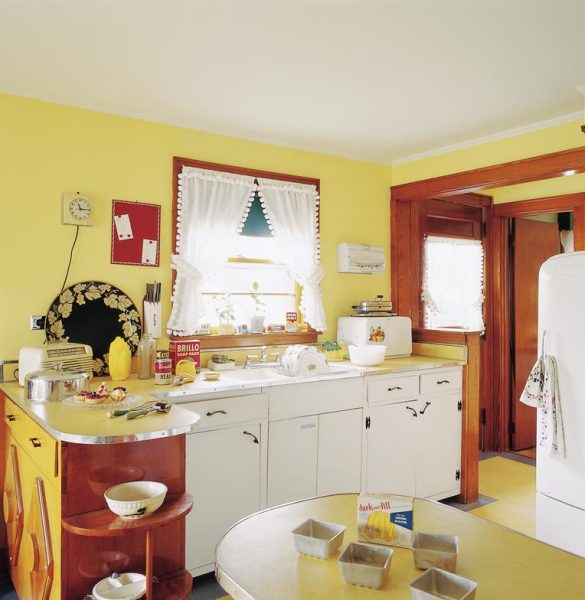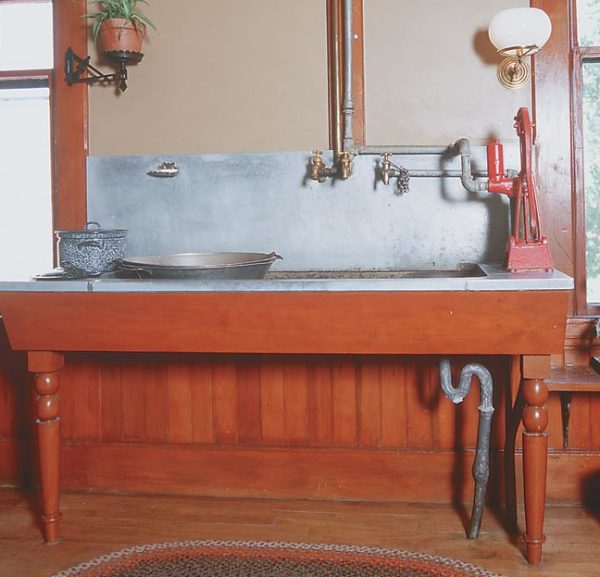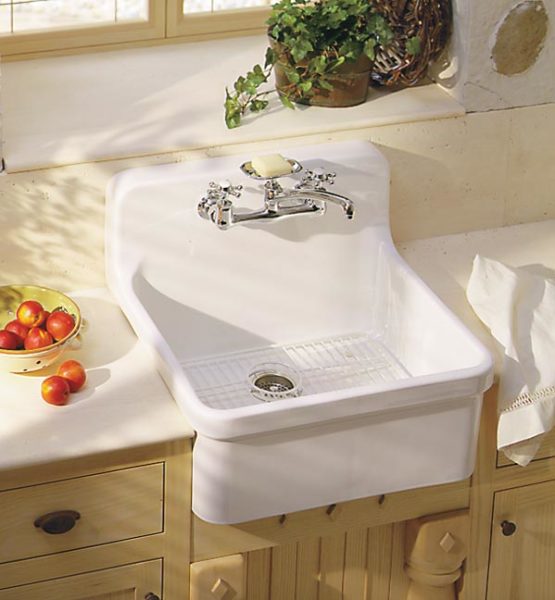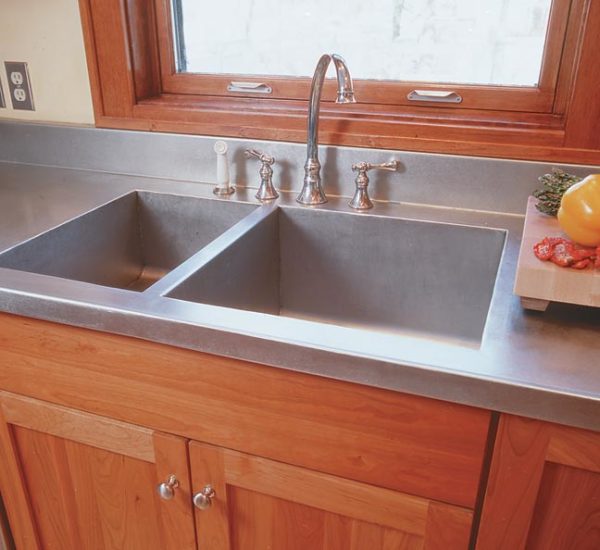The porcelain sink and laminate counter at the Shelburne Museum in Burlington, Vermont, perfectly capture the feel of a 1950s kitchen. (Photo: Carolyn Bates)
Even the most exacting old-house owners determined that every last spice jar and cup hook in their kitchen should be genuinely historic may quail when it comes to choosing an appropriate kitchen sink. Salvage dealers often stock only a handful, compared to dozens of clawfoot tubs and lavatories. “I don’t get a lot in,” says Tom Sundheim of Architectural Artifacts in Denver. “The kitchen was always the first room that anyone remodeled.” Unlike the bathroom lavatory, which might have been made of marble or china with fluted edges, the kitchen sink was likely to be prosaic in both shape and material, and to have become chipped and stained over the years. So when it came time to update the rest of the room, off it went to the local landfill.
When you do find kitchen sinks at a salvage yard, they’re predominantly the white enameled cast iron kind that graced a majority of kitchens from roughly 1900 to the 1940s. There were other materials used over the last century or so, but how do you know what’s right for your old house? Keep in mind that no choice is radically wrong. Our forebears were apt to use any number of materials, depending on available local resources, and these all changed over intervening decades.
However, you can make some assumptions based on region (heavy stone was expensive to ship from New England quarries, for instance) and technology (stainless steel wasn’t widely available until the 1940s).
Make Mine Metal
The cast iron sink and zinc surround at Billings Farm in Woodstock, Vermont, was handmade to be true to 1895. (Photo: Carolyn Bates)
When our great grandparents first brought running water into their homes in the 19th century, they often pumped it from a supply tank, usually into bowls or buckets set in a dry sink and metal trough built into a wooden cabinet. Many of the first wet sinks, like dry sinks, were metal lined. Two of the earliest available materials, used for butler’s sinks in wealthy turn-of-the-century houses, were copper and nickel silver (a copper, nickel, and zinc alloy often called German silver).
Nickel silver was harder and stronger than copper and, by varying the nickel content, could take on yellow, green, pink, and blue tones. Copper, as any of us who’ve invested in copper cookware know all too well, doesn’t retain its blinding shine without a lot of elbow grease. Most old-house owners are content to let it take on the dark brown patina of an old penny.
In the 1920s, an ore with a naturally occurring mix of copper and nickel (with a dash of iron, manganese, silicon, and carbon) was tapped to make Monel, a corrosion resistant, lightweight white metal.
These metals were supplanted by stainless steel after World War II, when copper and nickel were needed for the war effort. Stainless steel, a blend of several different iron and chromium alloys, was studied as early as 1821, but until 1909 no one knew how to make it corrosion resistant. The material took off in the 1940s and ’50s, not only for sinks but in countertops.
Stone and Ceramics
When the Neanderthals needed a water basin they probably used a big rock that had been eroded into a concave shape by centuries of rain. All the rage today is the apron-front, squarish farmhouse sink, which echoes the shape of stone sinks made in America for some 150 years. Yes, soapstone and slate sinks were found in farmhouses, but probably not in the Midwest or on the West Coast. Soapstone is quarried exclusively in Vermont (although some today come from Brazil). Slate has more widespread sources, along the Appalachians in Pennsylvania, Maryland, New York, Vermont, and Maine.
“I would say it hasn’t been until the last 10 or 15 years that our sinks have found their way clear across the country,” says John Tatko, general manager of Sheldon Slate in Monson, Maine.
In this region you may have a prayer of finding a salvaged slate sink. But buyer beware, says Tatko. The sinks may harbor hidden cracks from years of exposure to the elements, and you’ll have to custom build your cabinets to accommodate their odd sizes.
The retro look is “in” for kitchen sinks, but not always in the original material. Exceptions include Kohler’s Gilford sink in vitreous china.
Porcelain enameling, the process of applying ground glass to hot metal, has been used for ornament for hundreds of years, but it wasn’t until about 120 years ago that manufacturers figured out how to fire it onto heavy cast iron. By the 1920s cast iron was by far the most popular material for sinks. Early models were supported in front by iron legs, shaped to resemble furniture legs. Of course they were all white, as befit the national mania for antiseptic surfaces.
Next came wall-mounted sinks, and then those built into the countertop in a manner similar to dry sinks. Although color was introduced to porcelain fixtures in the late ’20s, most kitchens sported nothing more daring than a mottled oatmeal color even into the ’40s.
In the 1920s, plumbing fixture catalogs also mentioned earthenware sinks. These sinks had a base of solid ceramic, rather than cast iron, and were often enameled white inside and glazed brown on the exterior. Like the cast iron sinks, they came with either flat or rolled rims. Always heavy, they were more likely to be found in commercial kitchens and laundries. A ceramic material used in some reproduction sinks today is fire clay, which has a high melting point and is more commonly used to make fire brick.
Buying a reproduction sink in any of these materials means you’re more likely to find plumbing hardware that will fit its dimensions, especially hole spacing. If you’re lucky enough to find a salvaged sink with its original fixtures, remember that you’ll probably need to fix a leak or two and find adapters to hook it up to your plumbing system.
Making a Big Backsplash
Designer Gary Crowley was going for a ’20s feel when he chose a stainless steel sink for this kitchen. Monel, a white metal no longer common, might have been a more likely choice of that era. (Photo: Carolyn Bates)
You need to consider not only the countertop, but also the backsplash in generally, any protective material behind the sink and counter. As with sinks, any number of materials were used at any given time, but there are historical patterns in the use of metals, wood, ceramics and stone, and laminates.
Metal: The earliest metal sinks often had backsplashes of metal, possibly zinc or lead. Copper sinks found their way into the butler’s pantry because they were less likely to chip crystal than were stone sinks; there’s little evidence for matching counters, although copper is being adopted for counters now.
Also being marketed for backsplashes today are
pressed metal ceiling tiles. While there’s no proof that they were once a popular backsplash option, it’s easy to imagine a Victorian homeowner with a few of the decorative tiles left over applying them to the wall behind the kitchen counter. Monel and stainless steel sinks often had integral backsplashes.
Wood & Ceramics: A material that definitely did find its way from ceiling to backsplash was beadboard. Originally custom made, it gained popularity in the last half of the 19th century for walls in vacation cottages and other less formal structures and rooms.
Homeowners were at first content to varnish their beadboard or other wooden walls, but as concerns with sanitation grew at the turn of the century they covered kitchen walls with glazed white tiles, usually 3” x 6” subway tiles. White tile was frequently used behind coal-burning ranges, where it made the wall easier to clean, so it was logical to extend the tile to the sink area. Painted or sculpted tiles played an important decorative role early in the 20th century, primarily around the fireplace, but weren’t common in the kitchen until the late 1920s.
While marble makes a smooth, cool surface for rolling out pastry dough, it stains too easily to be practical for general food preparation. It could serve handsomely, though, in the less rigorous role of a backsplash. Granite, probably today’s most popular high-end counter material and one often used in “period-inspired” kitchens, would have been rare in early 20th-century houses. A process to cut granite slabs as thin as 1 wasn’t discovered until the 1930s, and the material remained prohibitively expensive until the 1960s.
When porcelain sinks came into fashion they usually had their own built-in backsplash and often integral drainboards as well.
A common companion for stainless steel sinks was laminates. The Formica Company developed its first light-colored faux wood-grain laminates in 1927, and their popularity grew as the material became more water- and heat-resistant. In the seven years following World War II, about one-third of new kitchens were dressed in Formica. Into the ’60s, laminates continued marching pinkly around American sinks. Today at least one company, Wilsonart, will match old laminate patterns by scanning them and reproducing them digitally.







